German Bread (Authentic Vollkornbrot)
This post may contain affiliate links. See my disclosure policy.
A thoroughly authentic German Bread Recipe (Vollkornbrot)! This delicious traditional German whole grain seed bread is nutrient dense with a fabulous texture and positively packed with flavor. This makes a large loaf that freezes well so you can conveniently grab some whenever you’re in the mood.
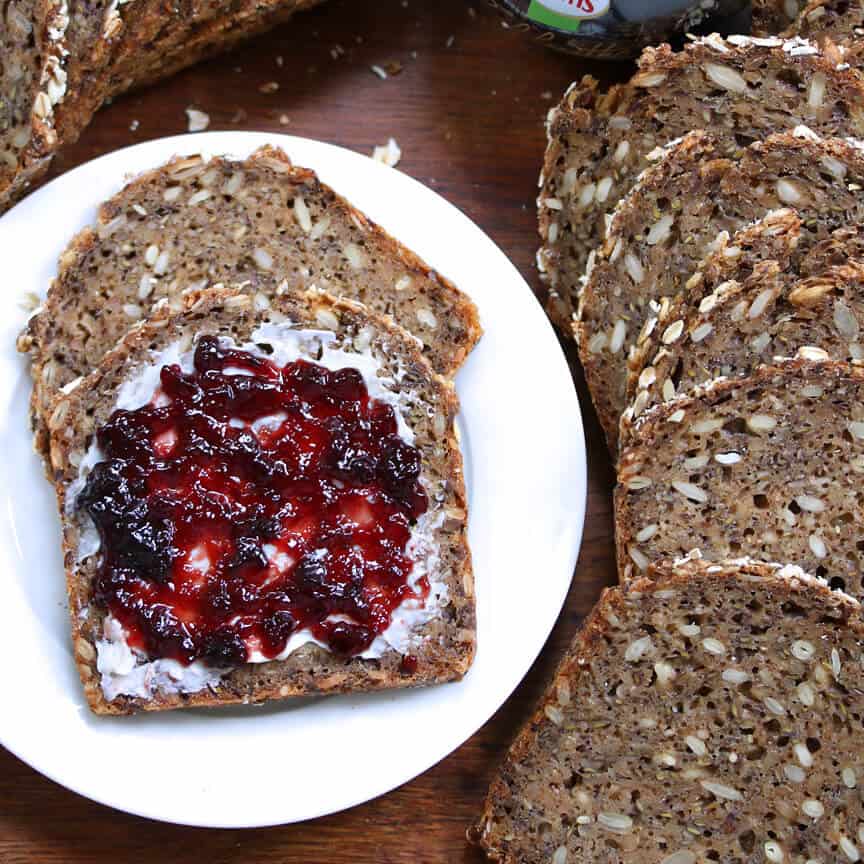
Authentic German Bread (Vollkornbrot)
Few things are better than a freshly baked loaf of bread slathered down with butter and some good jam. That’s true for crusty breads with fluffy interiors and the more hearty, dense breads that I also know and love from Europe. Here is a German bread that is beloved throughout Germany and is also widely enjoyed in Austria and Switzerland. It features a grain called Einkorn that is used throughout much of western Europe, but feel free to substitute other grains according to your preference.
Dense, chewy, packed with nutrition and full of flavor, this whole grain German brown bread (Vollkornbrot) is wonderful with your choice of butter, jam, Nutella, cheese, or cold cuts.
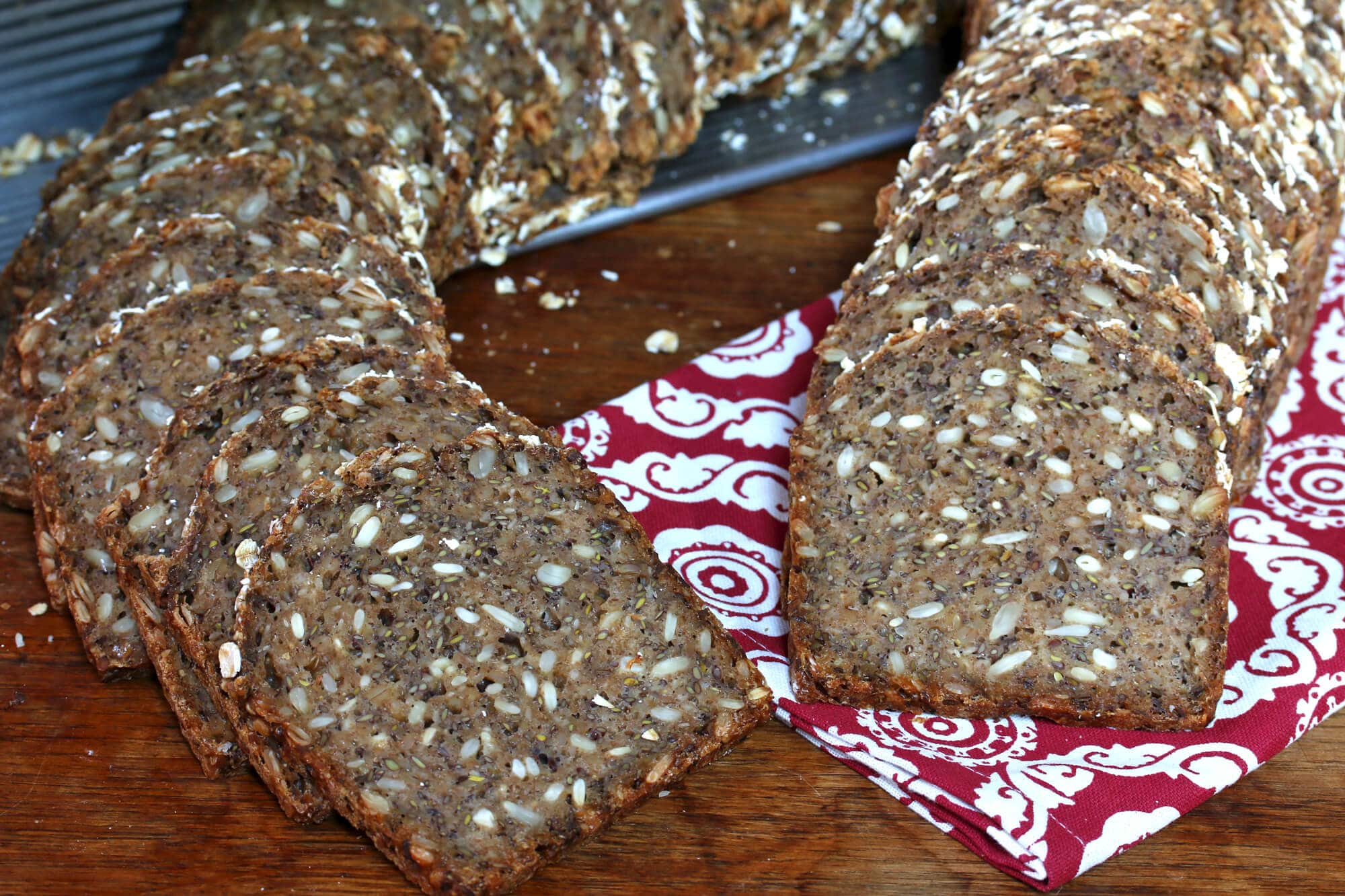
Have you heard of the grain einkorn before? Modern day wheat over the centuries has undergone a series of genetic changes for the purpose of increasing yield and gluten content. It’s almost unidentifiable compared to its ancestor (and my guess is that is why gluten issues are a more recent occurrence). Einkorn is the most ancient form of wheat on earth and hasn’t undergone these genetic changes. It is the purest form of wheat we have. You can purchase einkorn online HERE.
The advantages of einkorn: Most agree it tastes better than wheat and is much easier to digest, even easier than spelt. Compared to the gluten in modern day wheat, it contains a structurally different composition of gluten that the body is able to digest more easily. In fact, some people with gluten issues who have switched to einkorn have found that they’re able to tolerate and digest it with ease.
Even visually there’s a difference between wheat and einkorn. Though there are size variations within different types of wheat, generally most wheat (left) is longer in length than einkorn (right). Einkorn also has a deeper caramel color.

It’s unfortunate that as wonderful as Einkorn is, and common as Einkorn is in many places throughout western Europe, it’s almost unheard of here and very few places sell it. And for that reason it’s also much more expensive here in the U.S.. Hopefully that will change as it becomes more common. The same was true of spelt for a long time and though it’s still far less common than wheat here in the U.S. its price-point has gone down.
I buy all of my grains, including einkorn, in bulk. I take out what I need for a few weeks at a time and store the rest in a dark, cool place. It saves money that way and I have easy access to everything I need. And I LOVE being able to grind my own grains fresh as needed and make up my own fresh baking mixes!
My German-made KoMo grain mill is the pride and joy of my kitchen. German engineering at it’s best, the KoMo grain mill is simply awesome. You can grind your grains as fine or as coarsely as you like. With a 12-year warranty this thing is a work-horse and does a magnificent job. I use it nearly every day grinding my own flours, making cornmeal and a variety of mixes. I cannot recommend it highly enough.

This traditional German bread uses a combination of whole einkorn berries and ground einkorn flour. Whether you’re grinding your own grains or buying the flour already ground, you’re absolutely going to love the texture and flavor of this wonderfully hearty, rustic and thoroughly authentic German bread!
German Sourdough Bread
A couple of our readers have reported back about using sourdough starter instead of yeast. To make this a sourdough Vollkornbrot omit the yeast, add 200 grams of active sourdough starter, and reduce the flour by 100 grams and the water by 100 grams. Give the batter a full 24 hour ferment.
German Bread Recipe (Vollkornbrot)
Let’s get started!
Dissolve the yeast and sugar in the lukewarm water and let sit for 5-10 minutes until frothy. (See above if you prefer to use sourdough starter.)
Place all of the dry ingredients in the bowl of a stand mixer. (You can do this by hand if you prefer.)
NOTE: I personally don’t pre-soak the whole or cracked grain berries and let my batter ferment for a full 24 hours which softens the berries. Depending on the age of the grains you’re using they may require a pre-soaking in order to be adequately soft. If you wish you can pre-soak the grains overnight (pour hot water over them and let them sit) and then thoroughly drain for an hour or so.

Add the yeast mixture along with the buttermilk and beer. Knead on the bread setting (#2) for 10 minutes.
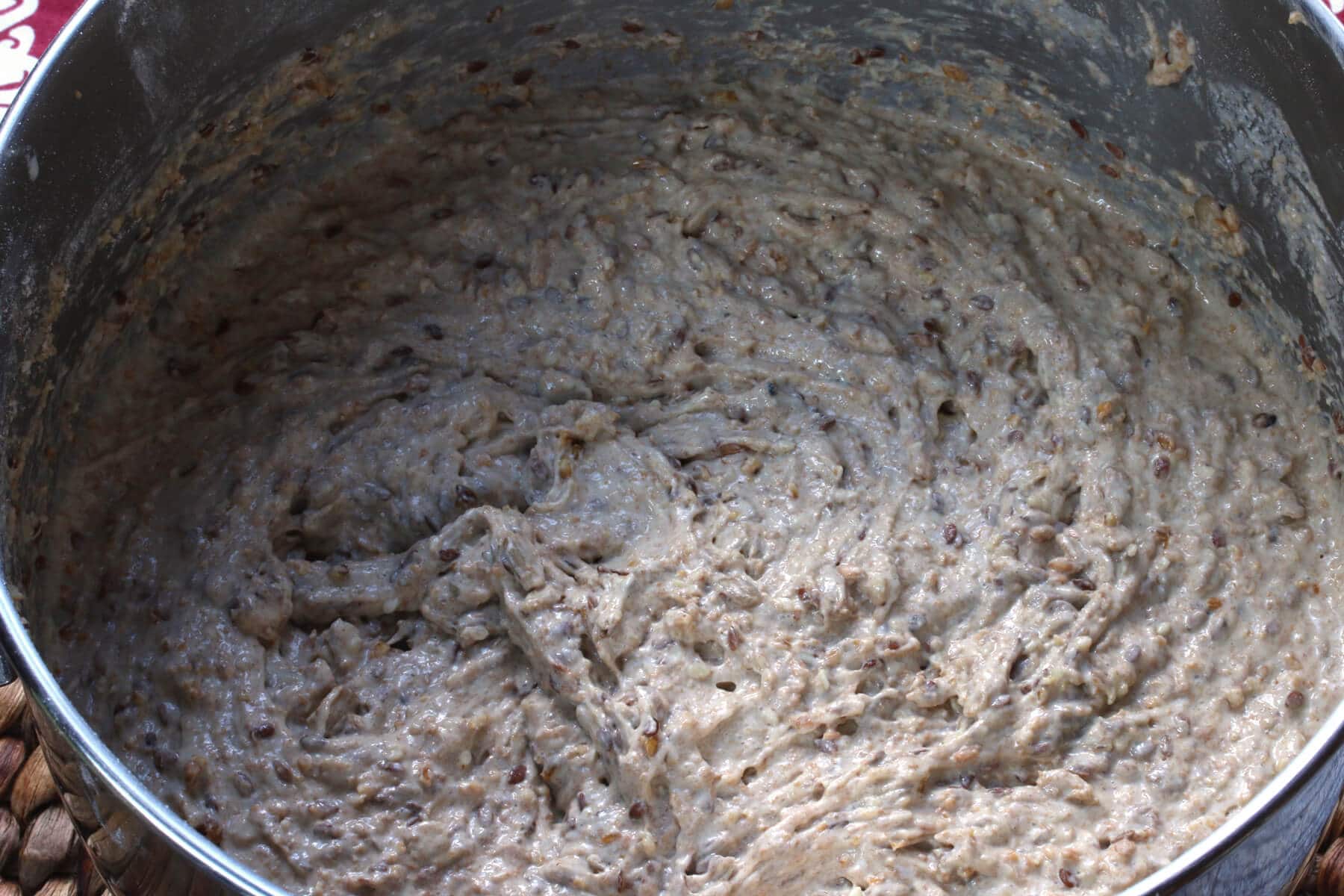
Scoop the mixture into a non-reactive bowl, cover loosely with plastic wrap and let it sit at room temperature for at least 8 hours, preferably longer, up to 24 hours (the longer the better for the whole grain berries to soften and for heightened sourdough properties. If you’re letting it sit for less than 24 hours, presoak the grains overnight in advance and drain thoroughly). Also, the longer it ferments the more liquid will be absorbed so less chances of a moist center after baking.
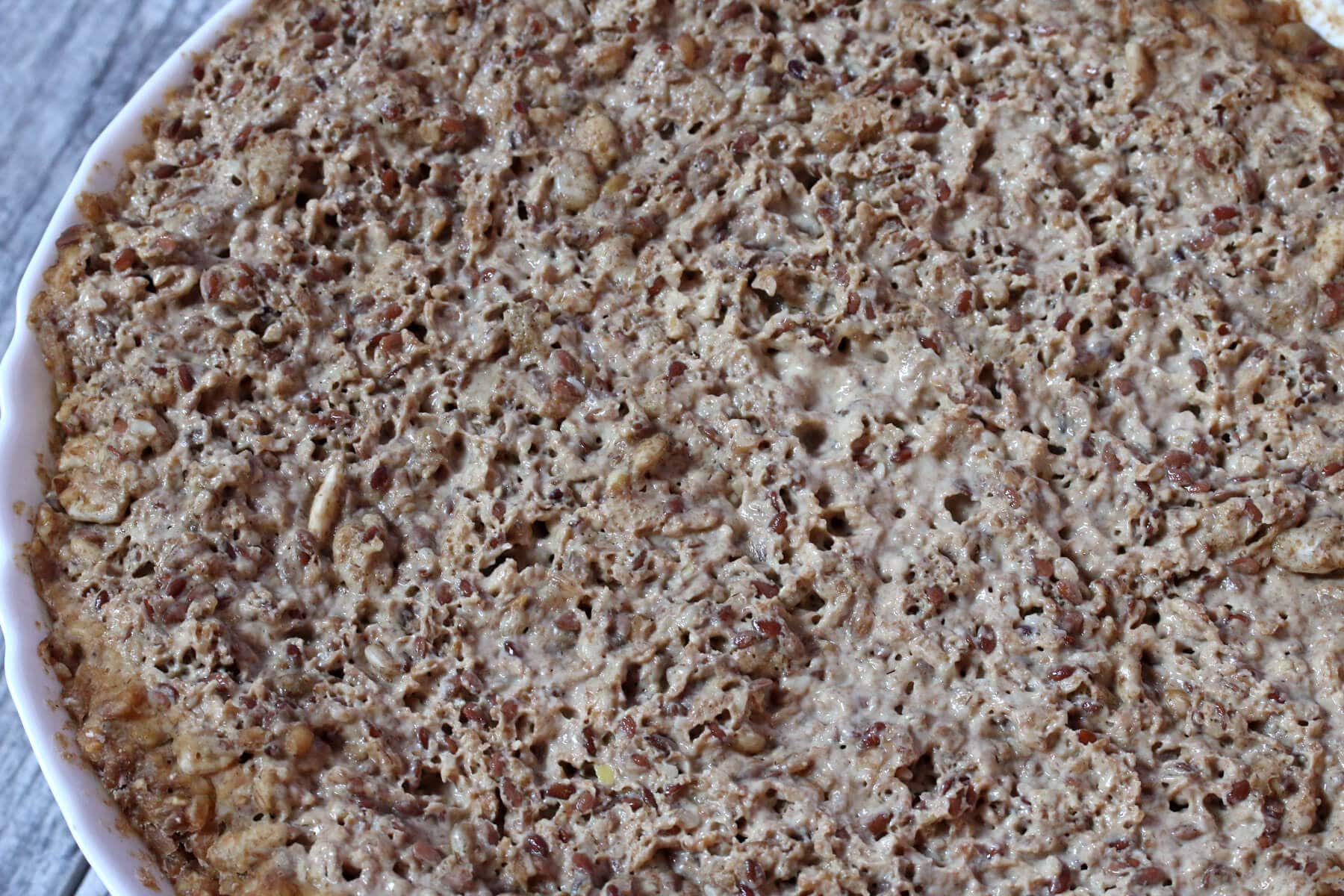
The mixture will be thick and gooey but will not resemble typical bread dough.
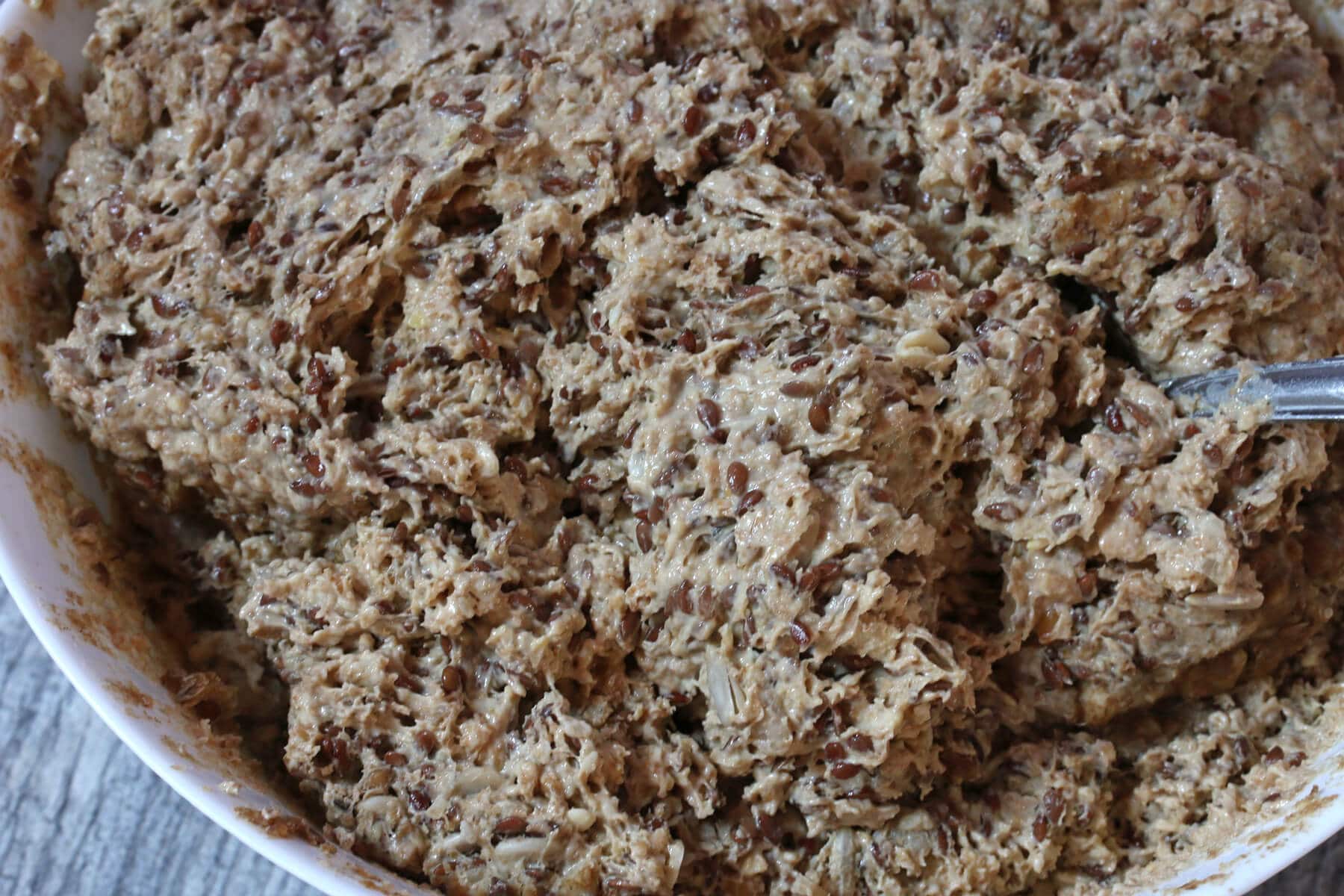
Scoop the mixture into a generously buttered Pullman Loaf Pan and smooth the top so it’s even.
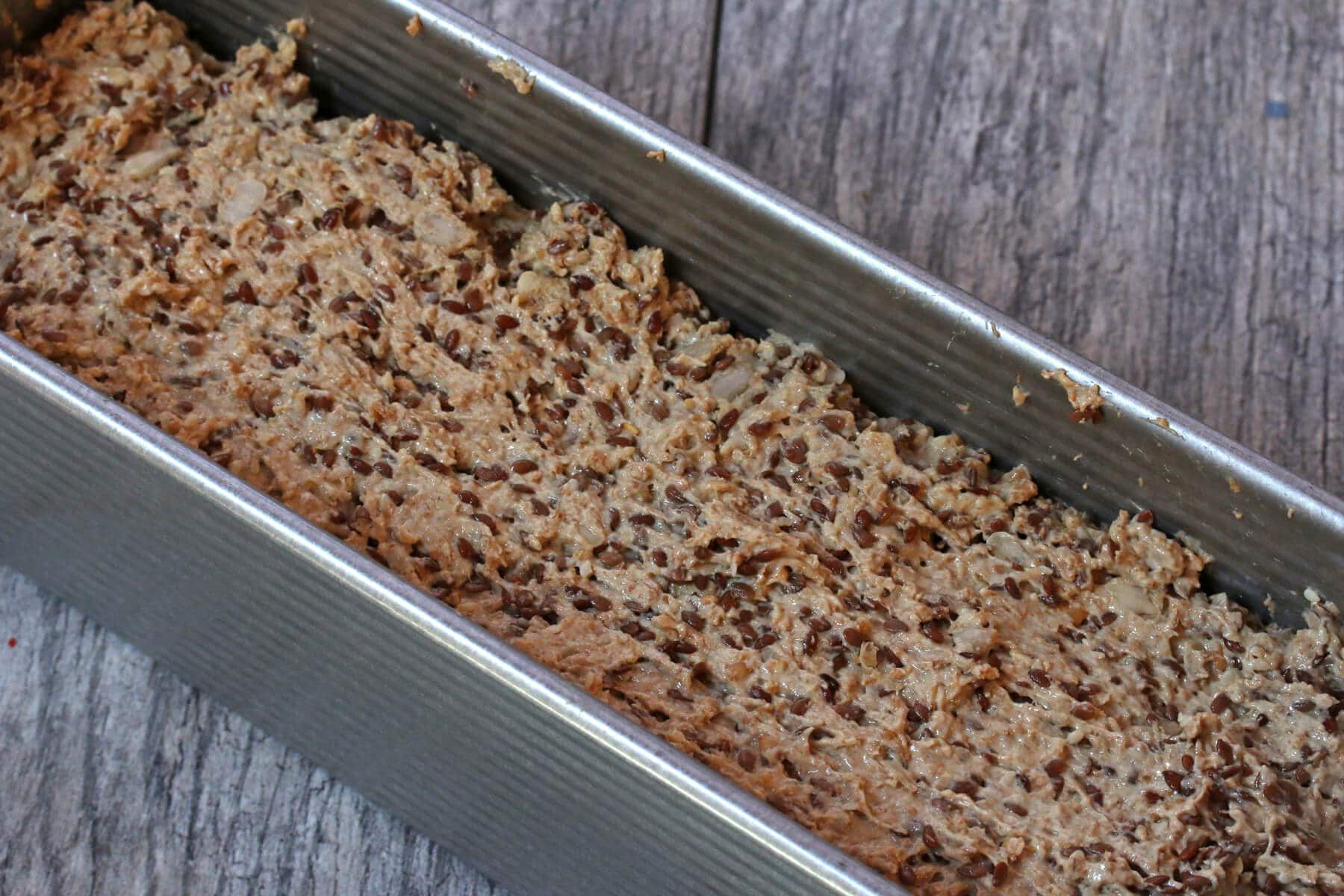
Baking this bread in a Pullman loaf pan yields those nice small, square slices of bread. But it also helps ensure that the center of the bread is fully cooked. Plus, when I’m making other breads that rise a lot, the Pullman has a top on it that slides shut to keep the bread compact (this Einkornbrot doesn’t rise a lot during baking so I don’t bother putting the lid on for it). It’s also the loaf pan that is used to make the famous French pain de mie bread. I like to use it for a lot of my heartier European style breads.
Sprinkle the top with rolled oats.
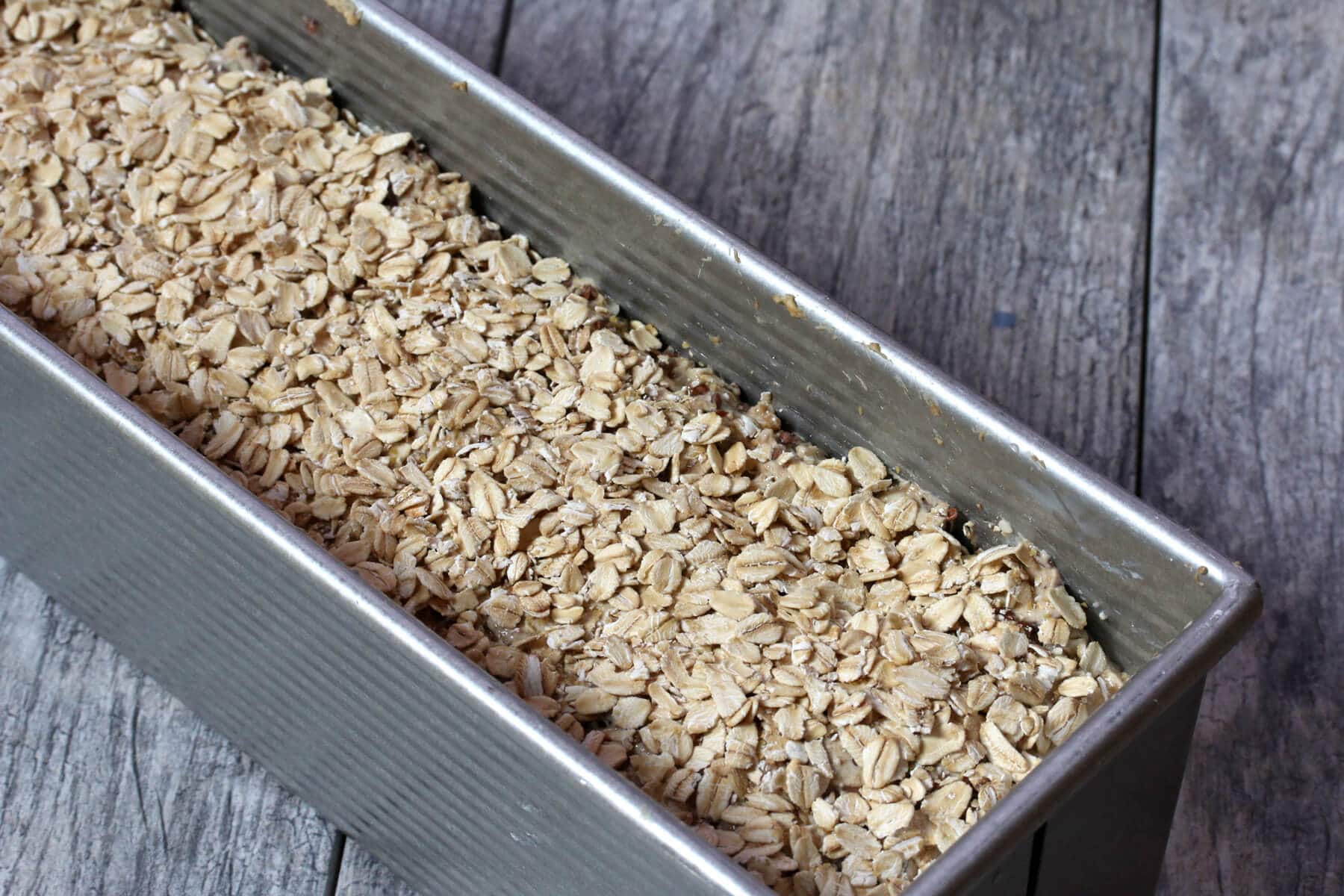
In an oven preheated to 350 degrees F, bake it on the middle rack for 100-120 minutes or until the center is done.
For best and most accurate results, use an instant read thermometer and aim for an internal temperature of 205-210 degrees F.
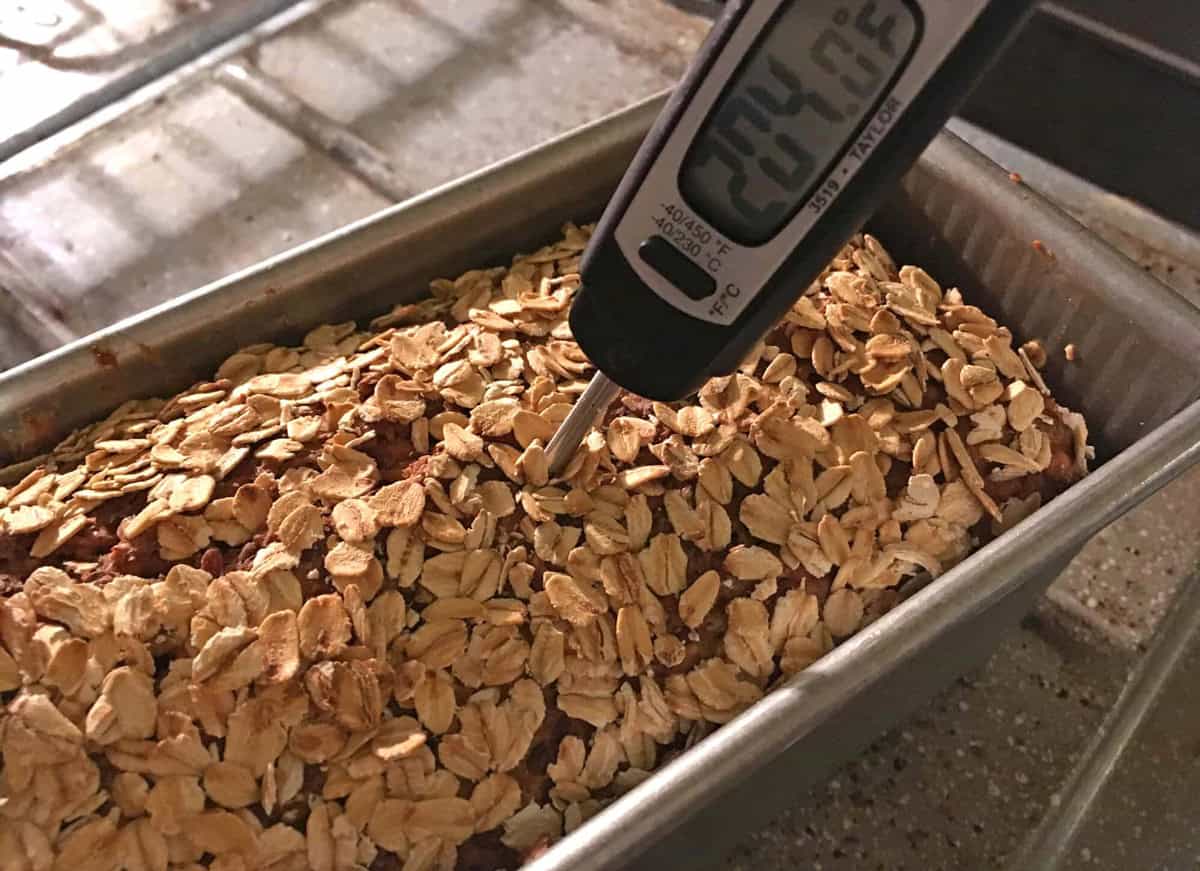
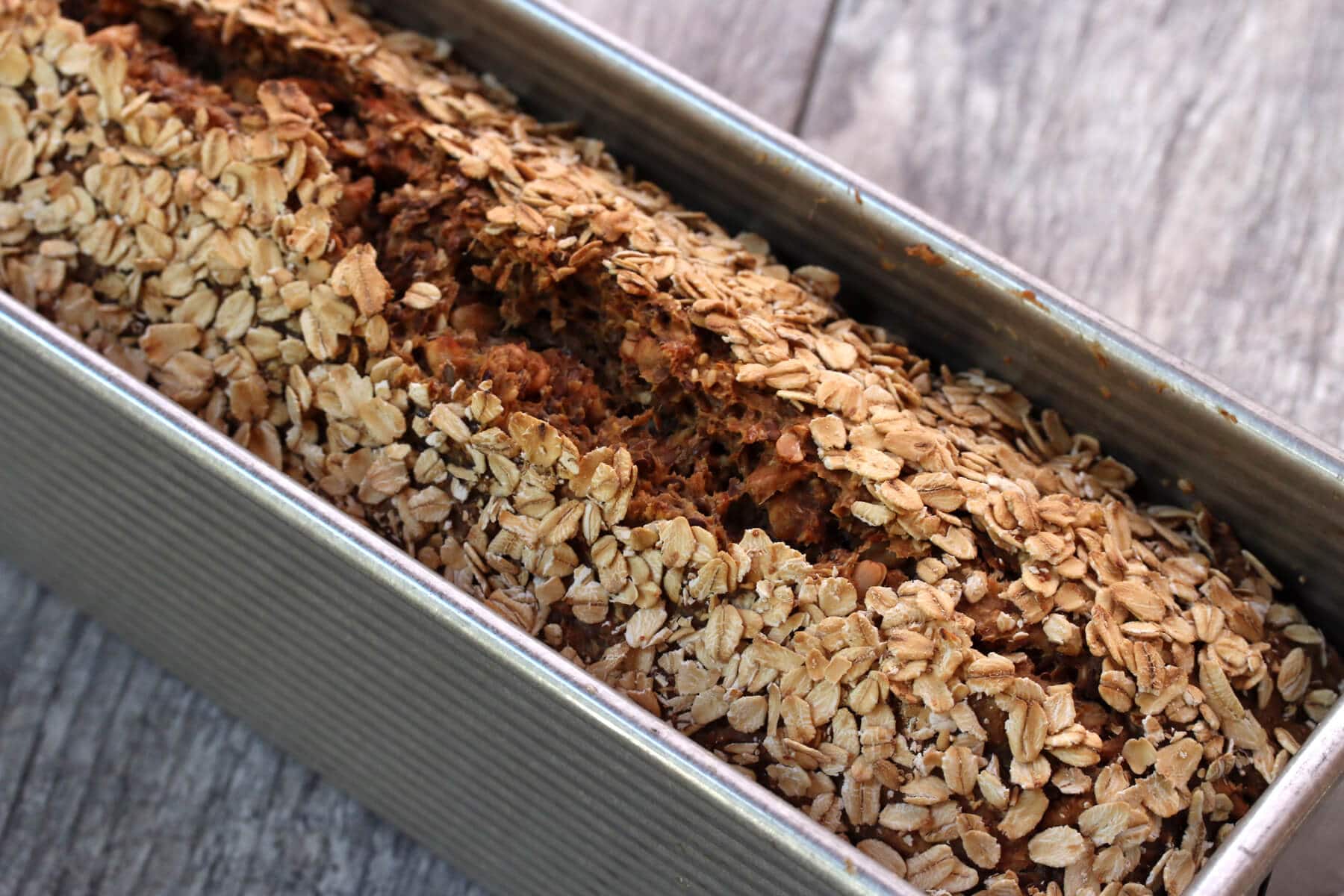
Let is sit in the pan for 5 minutes before removing it, then let it cool completely on a wire rack.
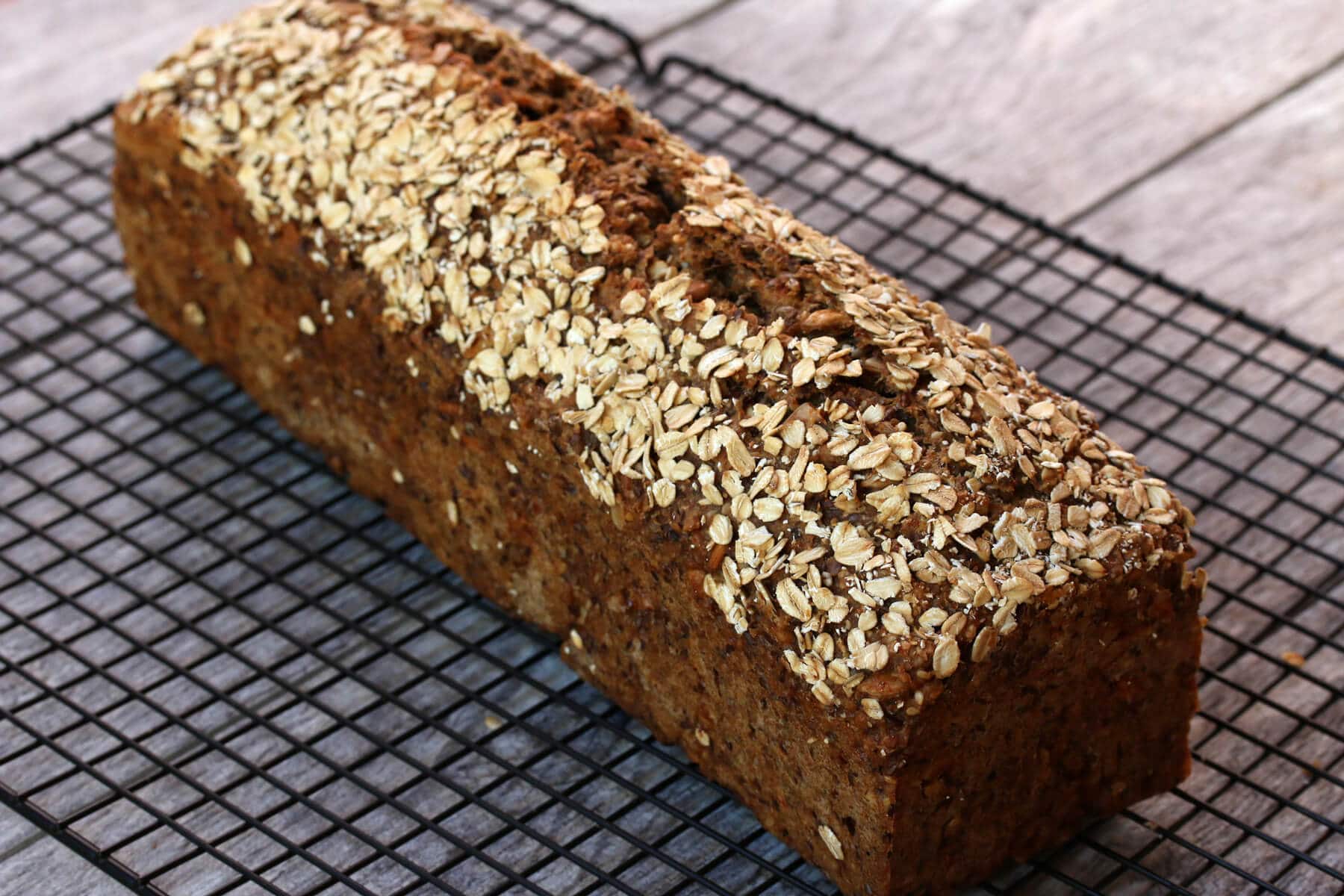
Once cooled you can slice the entire loaf in advance or slice as needed.
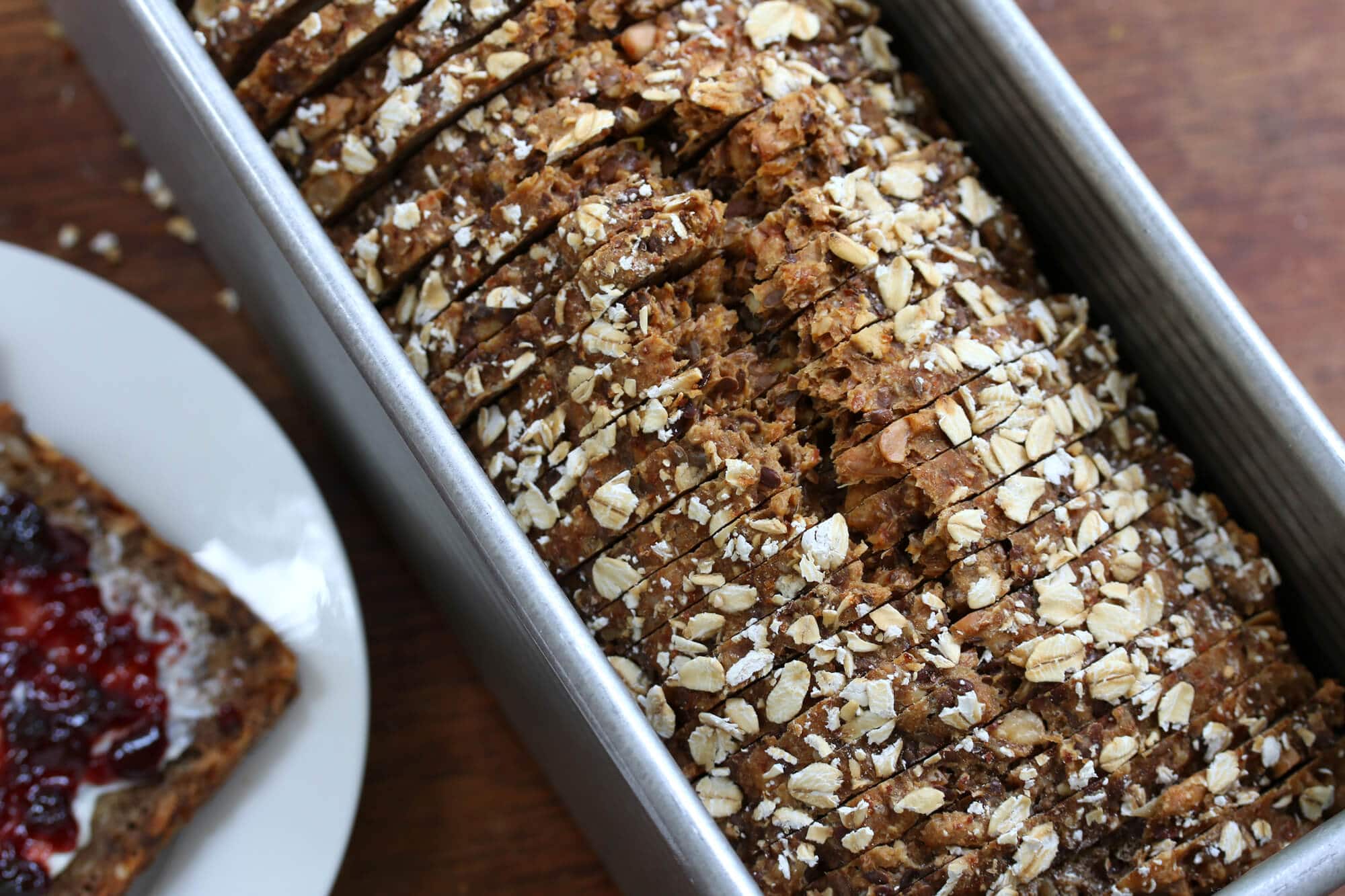
We have a decades-old Hobart commercial slicer that we picked up on Craigslist years ago. I used to be the manager of a delicatessen in England and Hobart is the gold standard in food slicers. In fact, the very same model that we have is on display at the Smithsonian!
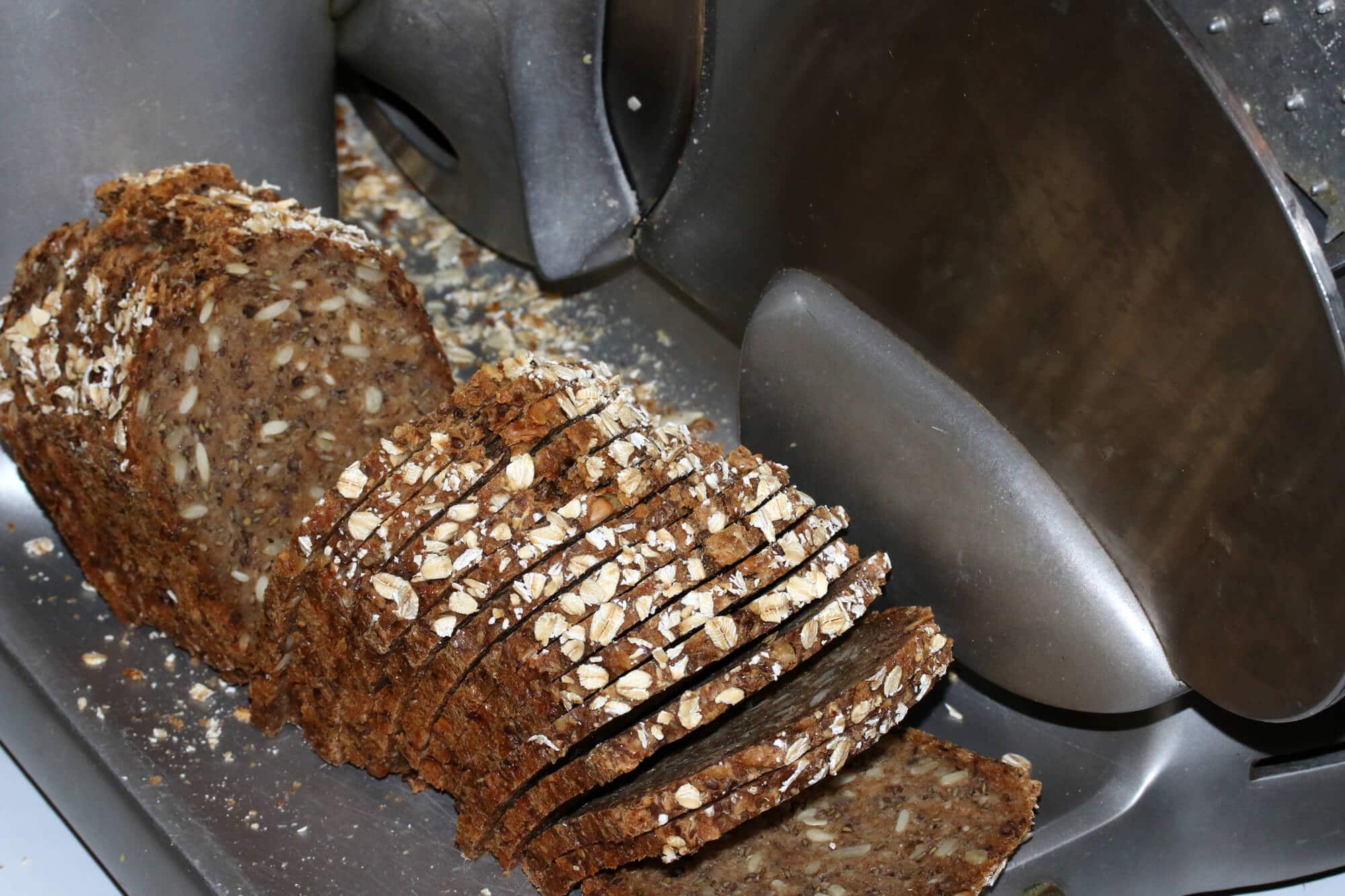
I realize we got lucky and most of you aren’t going to find a good-priced Hobart on Craigslist, but there are other good slicers on the market that are vastly cheaper and do the job. Chef’s Choice Slicers are consistently ranked at the top. I haven’t personally tried one, but they get excellent reviews. Having a good slicer to get clean, thin slices of bread that look like something you bought at a professional bakery is really nice. Plus, whenever I find chunks of cooked ham, turkey or cheese on sale I get those and slice them myself – it’s much cheaper than buying them at the deli.
At the very least you’ll need an excellent bread knife and for that my favorite knife, hands down, is the Cutco 9 3/4″ Slicer. It glides smoothly through bread and meat like no other.
Enjoy!
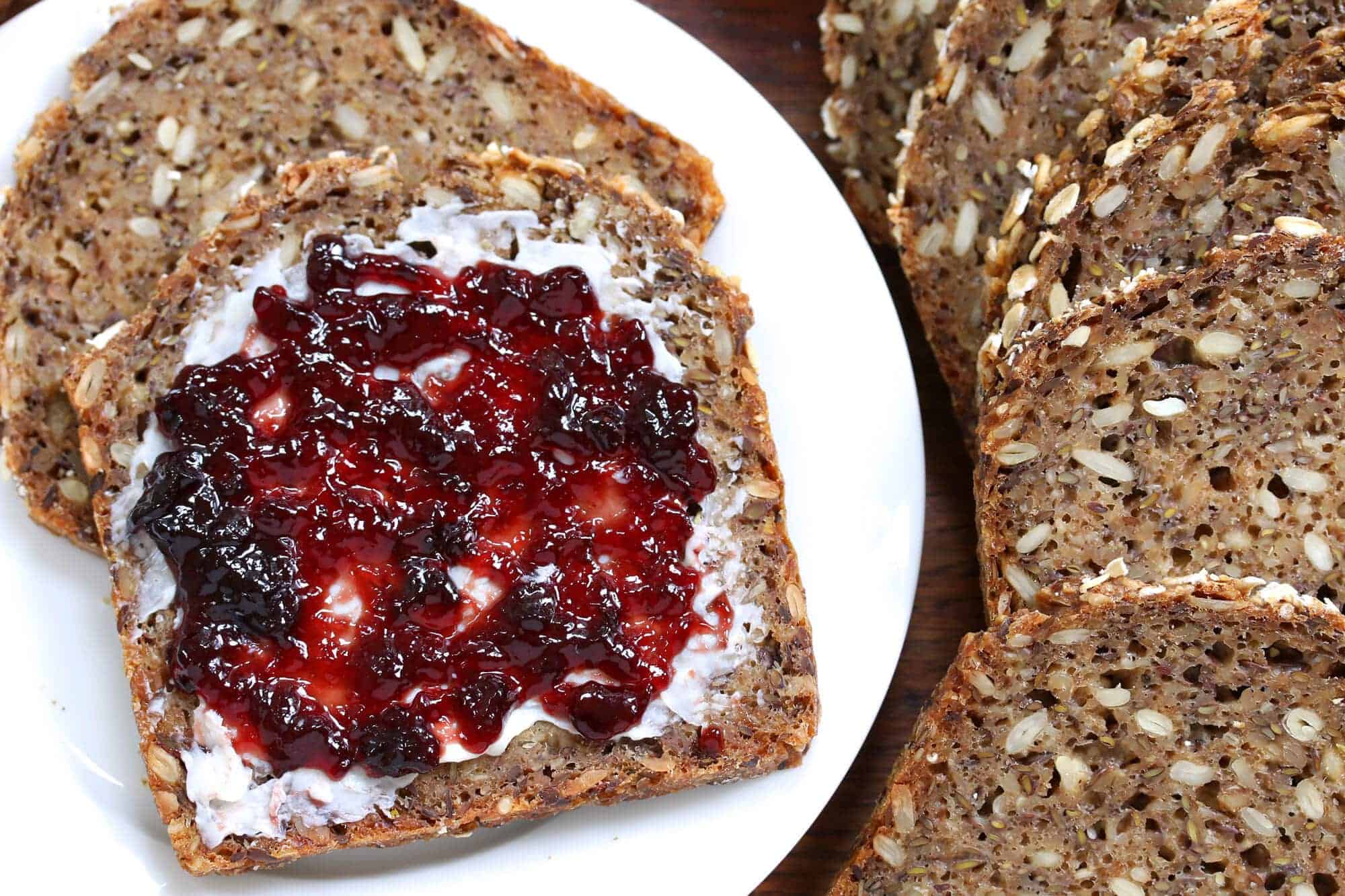
For more delicious bread from around the world be sure to try my:
- Lavash
- Injera
- Dosa
- Sourdough Naan
- Danish Rye Bread
- Crumpets
- Olive Rosemary Focaccia
- Skillet Cornbread
Save This Recipe
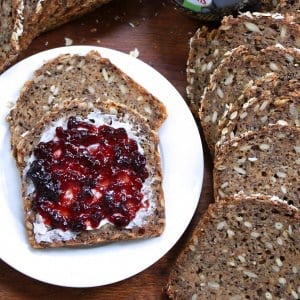
German Bread (Authentic Vollkornbrot)
Ingredients
- 4 1/2 cups einkorn flour (you can also use whole wheat, spelt, rye or combination)
- 1/2 cup whole einkorn berries , or wheat, spelt or rye berries (***See NOTE about soaking)
- 1 3/4 cups cracked einkorn berries , or wheat, spelt, rye (**See NOTE about cracking the grains **See NOTE about soaking)
- 1 cup whole flax seeds
- 1 1/2 cups sunflower seeds
- 1/4 cup sesame seeds
- 3 teaspoons salt
- 2 teaspoons dry active yeast ** see Note for sourdough substitution
- 2 tablespoons sugar , optional but recommended
- 2 cups lukewarm water
- 2 cups buttermilk , at room temperature
- 1 cup mild beer (optional, for a maltier flavor) , at room temperature (can substitute water or buttermilk instead)
- Rolled oats for sprinkling
Instructions
- Dissolve the yeast and sugar in the lukewarm water and let it sit for 5-10 minutes until frothy.
- Combine all of the dry ingredients in the bowl of a stand mixer. (You can do this by hand if you prefer.) Then add the yeast mixture along with the buttermilk and beer. Attach the dough hook and knead on the bread setting (#2) for 10 minutes. Scoop the batter into a large non-reactive bowl, cover loosely with plastic wrap, and let it sit at room temperature for at least 8 hours, preferably longer, up to 24 hours (the longer the better for the whole grain berries to soften and for heightened sourdough properties. Also the longer it ferments the more liquid will be absorbed so less chances of a moist center after baking.)
- Preheat the oven to 350 degrees F.
- Scoop the batter (it will be thick and gooey but not like regular bread dough) into a generously buttered 13x4x4 Pullman loaf pan and smooth the top to even it out. Sprinkle with oats. (Note: Baking this bread in a Pullman loaf pan yields those nice small, square slices of bread. But it also helps ensure that the center of the bread is fully cooked.) I always bake this without the lid on.
- Bake on the middle rack for 100-120 minutes or until the center is done. For best and most accurate results use an instant read thermometer and aim for 210 degrees F. Let the bread sit in the pan for 5 minutes before removing it, then let it cool completely on a wire rack before slicing it. To get clean, professional slices I highly recommend using a bread slicer.
Notes
- How to “crack” the whole berries: I use my grain mill to crack them by putting it on the coarsest setting. Another option is if you have a Vitamix and use the dry container – pulse the whole berries a few times until you get coarse pieces of einkorn. A powerful food processor will likewise do the job. Alternatively you can also place the whole berries in a ziplock bag and use a heavy object to pound them to break them up.
- Soaking the Grains: I personally don’t pre-soak the whole or cracked grain berries and just let my batter ferment for a full 24 hours which softens the berries, and I’ve always had great results. However, depending on the age of the grains you’re using (even if you just bought them they may have sat in the store or warehouse for a long time) they may require a pre-soaking in order to be adequately soft. If you wish you can pre-soak the grains overnight (pour hot water over them and let them sit) and then thoroughly draining.
- **Sourdough Substitution: To make this a sourdough Vollkornbrot omit the yeast, add 200 grams of active sourdough starter, and reduce the flour by 100 grams and the water by 100 grams. Give the batter a full 24 hour ferment.
Nutrition
Originally published on The Daring Gourmet December 11, 2019



















I think I am a little jealous of that brilliant grain mill and bread slicer! Thanks so much for the recipe – I love a good vollkornbrot. Will give this a try! Happy New Year :)
I consider myself very fortunate to have them them, Katerina! :) I hope you enjoy the bread. Happy New Year!
I’ve been trying to make an all rye sourdough bread for a few months now (since I returned from a trip to Tallin this summer), and have failed miserably to get it to rise and to bake all the way through. Your recipe for the German version of whole grain bread worked fantastically! Two things you suggest, a long fermentation and a long narrow pan is what I think made the difference in getting it to cook through. Thank you for posting this – I LOVE it!!
That’s wonderful, Laurie, I’m so happy to hear that, thank you!
That is amazing! Thank-you. I’ll share the results when I’ve tried it.
Can this bread be made with rye sourdough starter instead of commercial yeast?
Hi Ellen, yes it can. You’ll want to confirm this via an online search but once source states: “A quick rule to adapt recipes to sourdough is: Substitute 1 cup of starter for each package of yeast, and then subtract about 1/2 cup of water and 3/4 cup of flour from the recipe to compensate for the water and flour in the starter.”
I need to try this German Bread immediately, it looks so good!
What a hearty and flavorful bread! This will pair perfectly with my morning cup of coffee tomorrow; looks delish!
Hi Kimberly, I’m really excited about trying this bread. I am a bit concerned that I may have an inedible loaf on my hands like cowpoke and hmgurbanovna.
What are your thoughts on soaking the grain berries ahead of time? It would introduce a significant amount of water, which would throw off the proportions I would think.
Or could it be that some people are unknowingly using grain berries which are not fresh? Any thoughts? Thanks!
Hi Dee, I’ve made this bread at least a couple dozen times, have never soaked the berries in advance, and I’ve never experienced the problem with hard berries in the finished loaf. Most German recipes I’m familiar with that call for whole berries don’t soak them. So there’s definitely something going on for the two individuals you mentioned who experienced that problem. Your guess is the best I can come up with as well, which is a similar issue you’d encounter using old dried legumes that take much longer to soften than fresh dried legumes. And yes, my concern in soaking the berries would be the same as yours. My recommendation is to source your grains from a company you trust and to let the bread dough ferment for the full 24 hours to give the berries more time to soften.
Hello, unfortunately I don’t have any of these ingredients to add to the mix (whole einkorn berries or wheat, spelt or rye berries /cracked einkorn berries or wheat, spelt, rye) What do you suggest? Do I leave the same amount of einkorn flour? Thank you!
Hi Graciela, the whole berries and cracked berries add a very different composition to the bread than straight flour and the liquid measurements are based on that. To omit the whole and cracked berries would mean altering the entire recipe.
Thank you Kimberley, I wonder if I can use instead sunflower and pumpkin seeds. Maybe it won’t be the same but I will try as this bread is very tempting.
Hi Graciela, absolutely! Happy baking! :)